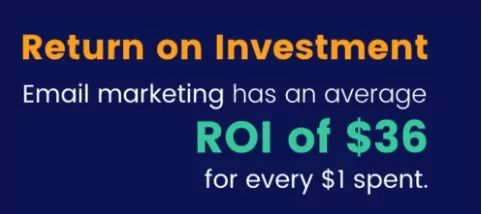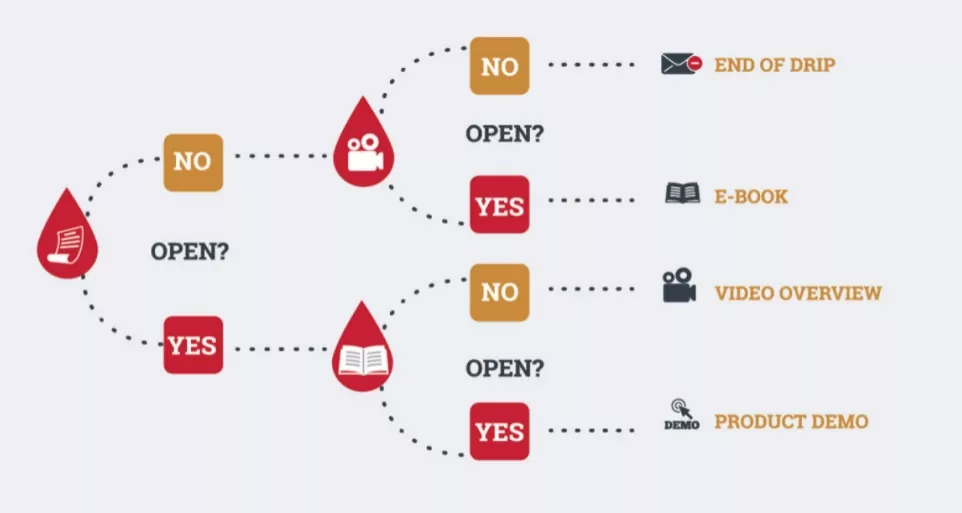As a business, you want to create loyal customers who keep your brand in mind. One popular way to do that is through drip marketing.
Drip marketing is also known as automated email marketing, marketing automation, or lifecycle emails. Automated emails are some of the best ways to connect with your customers and have the potential for big returns. Email marketing continues to offer an average ROI of $36 for every $1 spent.
This guide will show you what elements create the most effective drip marketing campaigns and how these campaigns benefit your business.
Key Takeaways
- Drip marketing email campaigns keep your brand fresh in your customers’ minds without being too pushy.
- Because drip campaigns are based on how a user interacts with your brand, recipients are typically more receptive to the message.
- With benefits like increased engagement and improved sales, drip campaigns are a good place to spend your marketing dollars.
Source: ConstantContact
What Is Drip Marketing?
Drip marketing is a steady stream of emails or other marketing materials sent automatically to a customer strategically and in intervals. It is a form of automated marketing. The name drip marketing comes from the agricultural practice of drip irrigation. Each marketing “drip” reminds the customer of your brand. The goal of drip marketing is to get the customer to make a purchase or complete another action.
Source: Restaurant Marketing Labs
Elements of a Drip Marketing Campaign
There are three key elements in a drip marketing campaign.
-
Triggers for Drip Marketing
A trigger is an event that sets a drip marketing campaign into motion. Depending on the type of business you run, you may have different triggers.
Some of the most common triggers for drip marketing include:
- Customers creating an account on your site
- Someone subscribing to your newsletter
- Creating a new lead
- Customers leaving your site with items in their cart
-
Conditions for Drip Marketing
While a trigger from the first step initiates a drip marketing campaign, the first email won’t be sent until certain conditions are met. Whoever plans your campaign will define what the conditions need to be. Some conditions could be waiting two hours after a customer leaves their cart before reminding them they forgot something or sending an email after a customer has clicked on a certain link.
-
Drip Marketing Actions
The action is the engagement element in the marketing campaign. In most drip campaigns, this will be the email. However, it could also be an SMS message, a push notification, or even a direct message on social media.
Benefits of Drip Marketing
A drip marketing campaign can have some remarkable benefits for your business. In addition to having an impressive ROI, drip campaigns usually generate more engagement. Some stats show a 119% increase in click-through rates.
Here are five major benefits of drip marketing:
- Sends the lead through the sales funnel: With an automated system, drip marketing campaigns naturally lead the prospect through the sales funnel without needing to interact with an employee. The campaign sends the right messages at the right times to generate a response from the customer.
- Improves lead engagement: One of the most important benefits to drip marketing emails is that they can be personalized to the prospect. Studies have shown time and time again that drip campaign emails that were triggered by a user’s actions are much more likely to get opened and get a response.
- Gradually nurtures the prospect: While there is some benefit to cold calling or cold emailing, many people view those tactics as an interruption in their day. However, with drip campaigns, the messages are customized based on what the user did. This automatically makes them more relevant and engaging. In addition, with a consistent drip of interactions, the prospect may be won over naturally.
- Increases up-selling: Once your initial drip campaign succeeds and you have earned a conversion, you can create a second wave of drip marketing. For example, sending them emails with related products or showing them what the next step is. This technique can lead to loyal customers and repeat purchases.
- Improves brand awareness: With a steady, yet non-invasive, stream of marketing, you can keep your brand at the forefront of your prospects’ minds. Each time they see your messages, they are thinking about your brand. Hopefully, your brand pops into their mind even without seeing a message from you.
How to Start a Drip Marketing Campaign
Drip marketing campaigns are relatively simple to start. Just like other types of email marketing campaigns, there are several key steps needed to see results.
-
Choose Your Target Audience
The first step in your drip campaign is choosing your target audience. You need to know who they are, what they need (or don’t realize they need), and how they act. This will give your campaign the personalized touches it needs to succeed.
-
Build Your Message
Once you know who you want to target with your campaign, you need to choose your message. You want the message to coordinate with the triggering action so the customer gets the right message at the right time. Focus on what you want your customers to do after getting your message.
-
Design Your Campaign
Your drip campaign should be broken down into multiple messages that will be sent out at specific times. Make sure each message naturally leads to the next and does not have contradictory information. Consider the following:
- How many emails do I want to send?
- When will each message go out?
- What is the best order for the emails?
- Do the emails correlate to the assigned triggers?
- How do I measure the results?
-
Start Your Campaign
Once everything is ready, you can officially start your drip marketing campaign and send out your first triggered email.
-
Evaluate Your Results
The last and perhaps most enjoyable part of a drip campaign is evaluating your results. Based on the unique links in each message, you can track how effective each message was. From there, you can make changes to improve your results for the next round.
Use the Expertise of MXTR Automation to Manage Your Drip Campaigns
The benefits of drip marketing are clear, but achieving great results with this approach takes some expertise. That is where MXTR Automation comes in. We are experts in delivering high-performing automated marketing campaigns that deliver real, measurable results.
Ready to see increased customer engagement with a new drip campaign? Schedule a demo with MXTR today.
Featured Image: istockphoto







